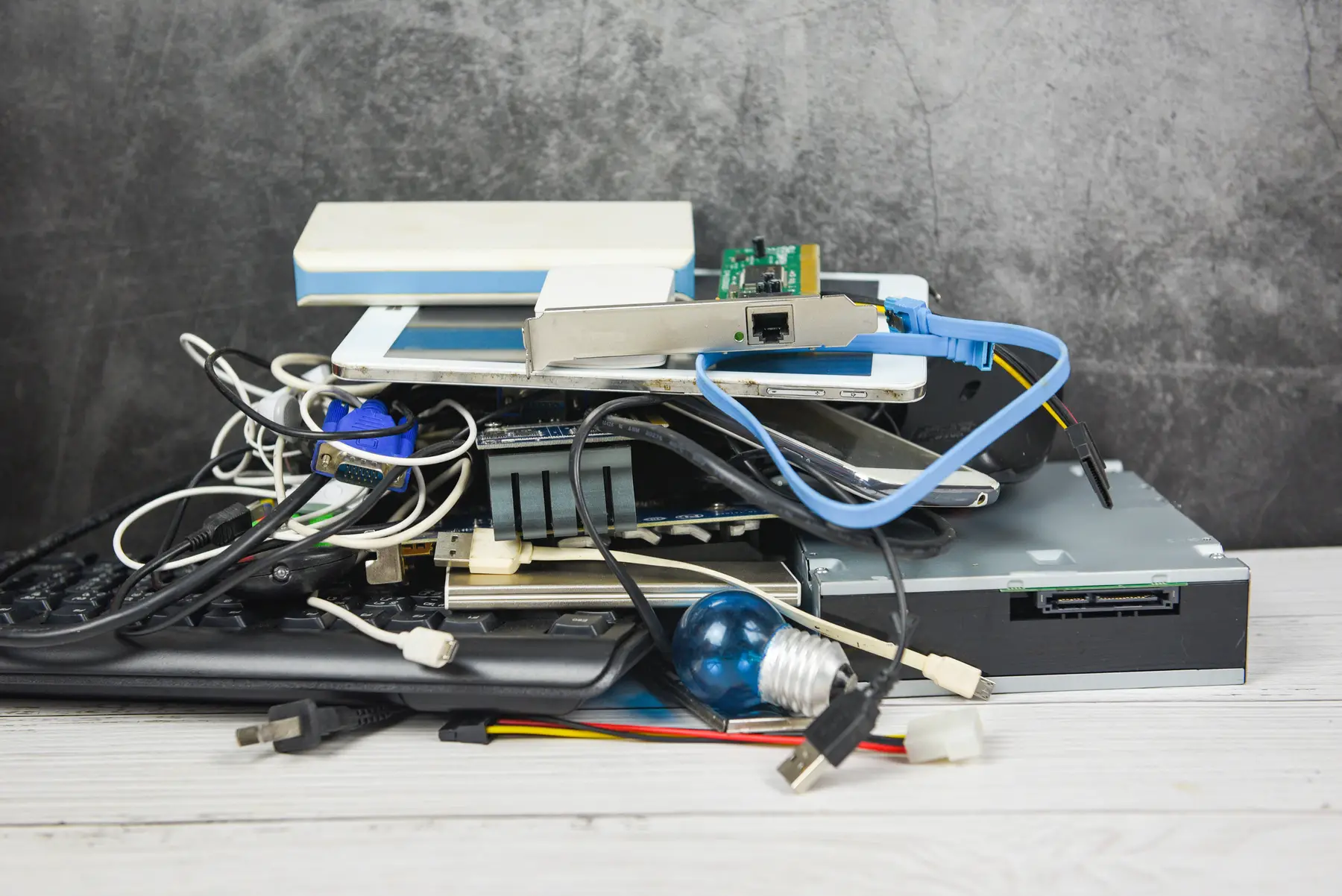
Learning how to reduce e-waste streams might be one of the biggest challenges of the digital age. The introduction of e-waste management techniques by principal generators—the companies, industries, and organizations who are the bulk consumers of electronic and electrical equipment—is an important step in efforts to reduce e-waste streams. Bulk generators of e-waste should invest in management techniques that incorporate the entire life cycle of the electronic products they use. Such techniques can be cost-effective, but also slow the growth and impact of e-waste, along with the potential environmental risks that accompany it.
What Is e-Waste?
The term e-waste, short for electronic waste, refers to discarded or obsolete electrical and electronic devices and components. This would include numerous consumer goods, and a substantial amount of IT and office equipment like computers, laptops, servers, CPUs, smartphones, tablets, televisions, printers, hard drives, fans, microwaves, DVD players, lamps, gaming consoles, and on and on. E-waste can also include the components and peripherals associated with these devices and equipment—keyboards, motherboards, circuit boards, batteries, surge protectors, and a myriad array of cables and wiring. Essentially, anything that contains electronic components or runs on electricity will eventually fall under the category of e-waste.
Growing Concerns of e-Waste
As a waste stream, the amount of e-waste generated annually has reached revised estimates of a staggering 63 million tons. On a practical level, the need to manage this waste stream has never been greater. However, because of the dangerous or hazardous materials that many electronic devices contain, managing and properly disposing of e-waste is also the law.
It’s not simply that many electronic devices contain harmful elements like lead, cadmium, beryllium oxide, chromium, or mercury and harmful compounds such as chlorofluorocarbons, brominated flame retardants, or polychlorinated biphenyls (PCBs)—they do. As landfills are the most commonly used method of disposing of e-waste, there is a real danger from accumulation of these elements and chemicals leaching into soil and water tables. Another common method of disposal, incineration, can release harmful gases and toxic fumes, with ashes containing harmful compounds like lead. If e-waste is managed and disposed properly, these toxins cannot leach into the environment nor pose risks to human health and ecosystems.
Growing concerns for an increase in e-waste can be attributed in large part to how electronics are consumed. With ongoing advances in technology, electronic devices become outdated and replaced by newer models relatively quickly, leading to the disposal of still fully functional devices. Continuous upgrades of electronic devices combined with marketing strategies designed to compel consumers to buy newer versions of products contribute to increased e-waste. On the other hand, many electronic products simply have limited lifespans. Made with cheaper parts and components, the cost to replace a device is often on par with repairing it, making it more practical to simply buy a new one.
e-Waste Management Techniques
Consider a Product’s Complete Life Cycle
One important management technique that bulk generators of e-waste could institute would be to consider the entire life cycle of an electronic product and their place in it. The role a company plays from the time the electronic device is acquired to the time it is discarded is, obviously, substantial. One way companies can contribute to reducing e-waste is by participating in a closed-loop supply chain that incorporates plans for the various stages of a product’s service life. This management technique increases sustainability by preparing for the reuse, repair, reclamation and recycling of the product. The technique serves as an integral component in the end-to-end management process vital to any circular economy model. In regard to electronic and electrical equipment, the idea is, by enabling recovery and reuse for end-of-life products, those products can be kept in service longer and, in doing so, will lessen the impact on the e-waste stream.
Reuse Functioning Devices
When considering a product’s entire life cycle then, an important first step to reduce e-waste would be to reuse the electronic devices and equipment that still function. These products can be donated or resold instead of thrown out. Another aspect of this end-to-end process is incorporating or utilizing repair services. Generators should look to repair malfunctioning devices and equipment first before recycling. Repairing the devices not only slows the demand for material, but reduces e-waste as well.
Donate to “Give Back” Programs
Another management technique to reduce e-waste is for your company or organization to participate, when applicable, in “Give Back” programs to the companies from where the electronic products were purchased. Many companies accept old electronic products to recycle, modify, donate, or resell at lower prices.
Recycle
Finally, proper recycling of dated electronic and electrical equipment is an important e-waste management technique that every business must observe. As e-waste is composed of dangerous or hazardous materials, generators are required by law to properly manage and dispose of the old equipment when its service life ends.
Contact the e-Waste Disposal Experts at Maine Labpack, Inc.
Maine Labpack assists its customers with managing and recycling their e-waste to provide a more sustainable practice for their companies. We serve a wide variety of industries and organizations, from telecom, OEMs, and microelectronic companies, to healthcare, educational institutions, research facilities, and government agencies. Whether the equipment is no longer in use or has become outdated, we can assist you with its proper disposal. We will ensure that your e-waste is transported to a destination facility where the electronics are categorized and taken apart either for the scrap to be collected and reused in manufacturing electronics and other equipment or to be shredded appropriately.
For more information on how we can help you effectively reduce your e-waste stream, contact the experts at Maine Labpack today.
